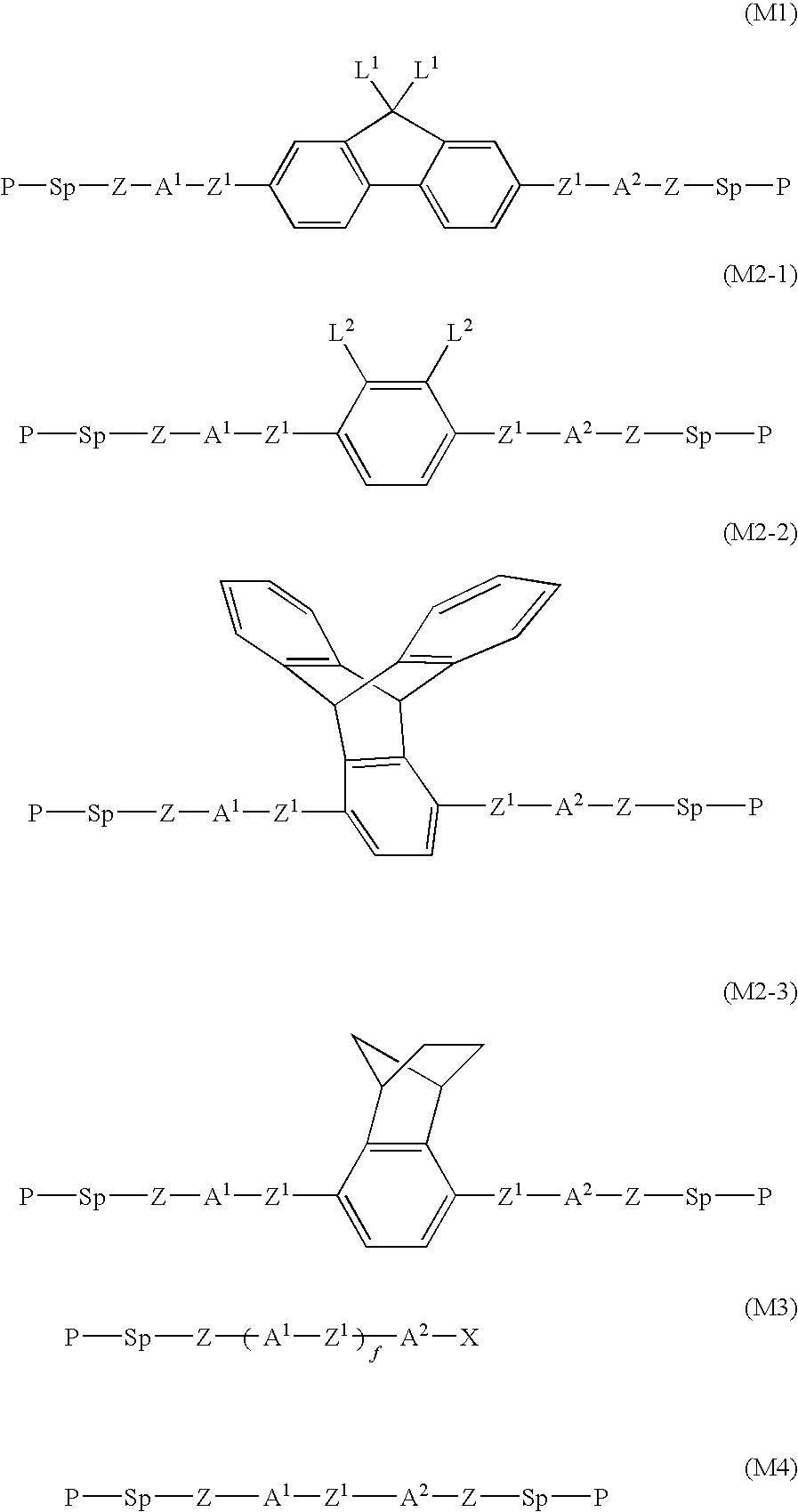Optically anisotropic substance
a technology of anisotropic substances and anisotropic substances, applied in the direction of thin material processing, liquid crystal compositions, chemistry apparatuses and processes, etc., can solve the problems of difficult application of rubbing treatment to optical films for optical use, and achieve excellent alignment ability, and ensure the reliability of optical anisotropic substances
- Summary
- Abstract
- Description
- Claims
- Application Information
AI Technical Summary
Benefits of technology
Problems solved by technology
Method used
Image
Examples
example 1
Preparation of the Varnish A1 Including Polyamic Acid Having Divalent Azobenzene Group
[0257]The diamine (1-1) (2.4660 g) and dried NMP (55.00 g) were introduced into a 200 ml four-neck flask equipped with a thermometer, stirrer, a starting material inlet and nitrogen gas inlet, and were stirred for dissolution under a nitrogen atmosphere. The acid anhydride (A-1) (2.5340 g) was added while the reaction mixture was kept at 5° C. After the reaction for 30 hours, BC (40.00 g) was added, giving the varnish in which the concentration of the polymer component was 5% by weight. After the stirring at around 60° C. for 4 hour, the varnish A1 having a viscosity of 33 mPa·s was obtained. The weight average molecular weight of the polyamic acid in this varnish was 52,000.
example 18
Preparation of the Substrate A1 with a Photo-Alignment Layer
[0261]The varnish A1 described in Example 1 and a diluent solvent NMP / BC=1 / 1 (% by weight) were mixed, and the varnish A1 was diluted to 3% by weight. The polyamide acid solution (3% by weight) was dropped on an alkali-free glass plate (type 1737 made by Corning, Inc.), and applied by the spinner method (2,000 rpm, 15 seconds). After the application, the substrate was heated at 80° C. for 3 minutes and the solvent was evaporated. Then the substrate was irradiated with linearly polarized light (energy being about 2 J / cm2 at 365 nm) through a polarizing plate, giving the substrate A1 with the photo-alignment layer.
examples 19 to 35
Preparation of the Substrates A2 to A18 with a Photo-Alignment Layer
[0262]The substrates A2 to A18 with photo-alignment layers were obtained by a method similar to that of Example 18 except that the varnishes described in Table 4 were used.
TABLE 4DryingTemperatureIrradiation withExamplePhoto-alignedof SubstratePolarized UVNumberSubstrateVarnish(° C.)(J / cm2)Example 18A1A1802Example 19A2A2802Example 20A3A3802Example 21A4A4802Example 22A5C1802Example 23A6C2802Example 24A7C3802Example 25A8C4802Example 26A9C5802Example 27A10C6802Example 28A11C7802Example 29A12C8802Example 30A13A11202Example 31A14A31202Example 32A15A41202Example 33A16A1800.9Example 34A17A3800.9Example 35A18A4800.9
PUM
 Login to View More
Login to View More Abstract
Description
Claims
Application Information
 Login to View More
Login to View More - R&D
- Intellectual Property
- Life Sciences
- Materials
- Tech Scout
- Unparalleled Data Quality
- Higher Quality Content
- 60% Fewer Hallucinations
Browse by: Latest US Patents, China's latest patents, Technical Efficacy Thesaurus, Application Domain, Technology Topic, Popular Technical Reports.
© 2025 PatSnap. All rights reserved.Legal|Privacy policy|Modern Slavery Act Transparency Statement|Sitemap|About US| Contact US: help@patsnap.com



